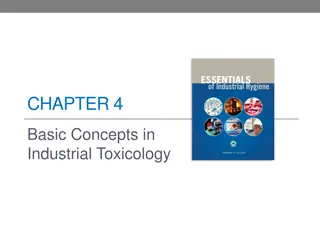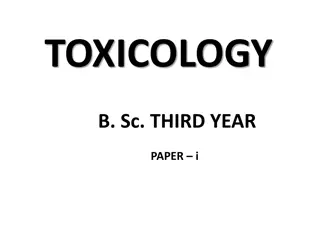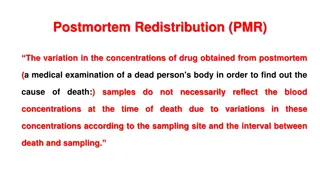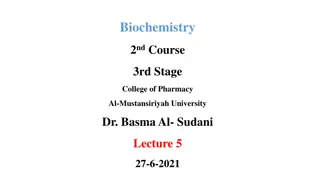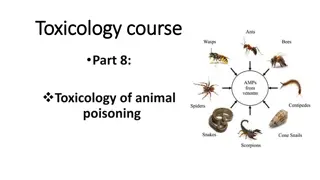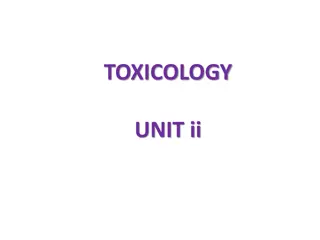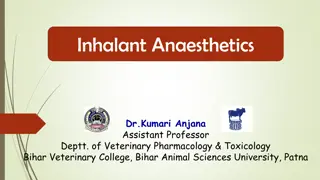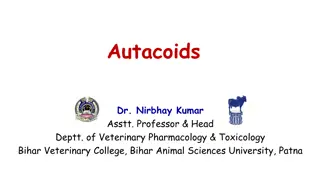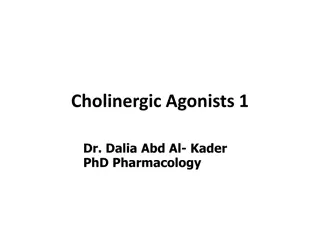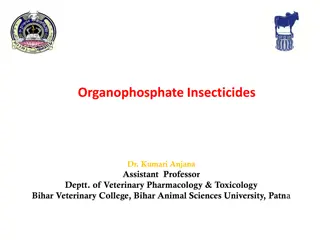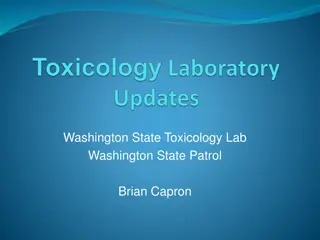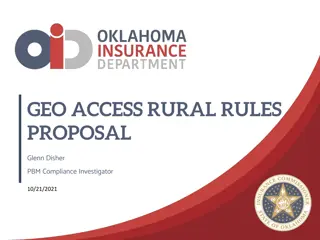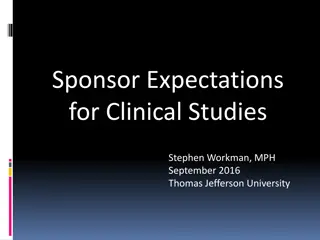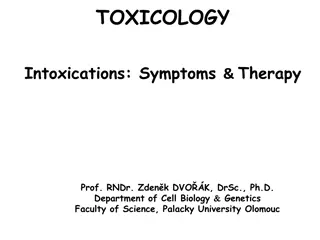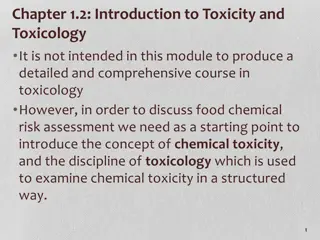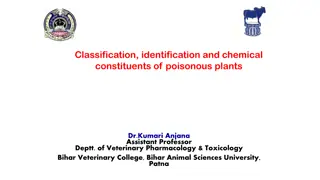Understanding Pharmacology and Toxicology in Investigator Brochures
Explore the essential aspects of pharmacology and toxicology covered in Investigator Brochures, including nonclinical information, safety pharmacology, general toxicology, genetic toxicology, and more. Learn about the significance of pharmacology in predicting intended and unintended effects, considerations for different drug types, and the importance of assessing toxicities in preclinical studies.
Download Presentation

Please find below an Image/Link to download the presentation.
The content on the website is provided AS IS for your information and personal use only. It may not be sold, licensed, or shared on other websites without obtaining consent from the author. Download presentation by click this link. If you encounter any issues during the download, it is possible that the publisher has removed the file from their server.
E N D
Presentation Transcript
Pharmacology/Toxicology in the Investigator Brochure Brenda J. Gehrke, Ph.D. Office of New Drugs/CDER/FDA November 2016
Abbreviations ADME: absorption, distribution, metabolism, excretion HU: hydroxyurea IB: Investigator Brochure ICH: International Council for Harmonisation IGFR: insulin-like growth factor receptor IND: Investigational New Drug application MOA: mechanism of action mTOR: mammalian target of rapamycin PNH: paroxysmal nocturnal hemoglobinuria 2
Objectives An overview of Pharmacology/Toxicology (nonclinical) information Pharmacology Safety Pharmacology Toxicology General toxicology Genetic toxicology Other toxicology studies: reproductive toxicity Examples of toxicity data 3
Nonclinical information included in the Investigator Brochure (IB) Pharmacology Safety Pharmacology Toxicology General toxicology Genetic toxicology Other toxicology studies Pharmacokinetics 4
Pharmacology Used to define intended and unintended targets/ effects Amount of information varies Type of molecule (e.g. small molecule vs biologic) Stage of drug development Indication 6
How much attention to pay to the pharmacology? Drug not the first in class? Better idea of toxicities For biologics (e.g. an antibody): which species best predicts toxicities in humans Can explain some toxicities seen in animals: exaggerated pharmacologic effects 7
Safety Pharmacology Cardiovascular In vitro In animals (dogs or monkeys) CNS (usually rodents) Pulmonary (usually rodents) 9
General toxicology Toxicology studies with the same route and schedule of administration as proposed in subjects: Duration of nonclinical studies relative to clinical development described in ICH guidance M3R2 Anticancer pharmaceuticals follow ICH S9 11
Purpose of these studies Determine whether it is safe to put drug candidate into humans Determine an initial safe dose for human clinical trials Help determine a safe stopping dose (if necessary) Identify dose limiting toxicities (what should be monitored in clinical trials) Assess potential toxicities that cannot be identified in clinical trials 12
Which Species to Test Regulatory guidelines accept data from a variety of species In practice, only a small number of rodent and nonrodent species are consistently chosen Species are chosen because they have been used before, and studied extensively 13
Species Commonly Used Rodents Rats Mice Non Rodents Beagle dogs Cynomolgus and Rhesus monkeys Rabbits 14
Species in toxicology studies For biotech derived products, e.g. an antibody, the species should be pharmacologically relevant. Toxicology studies in a second species may be waived if no other relevant species has been identified. 15
Toxicity information in the IB: Real examples Indication: Treatment of systemic amyloidosis Target: amyloid fibrils Drug: Humanized IgG1 monoclonal antibody Target not present in healthy animals (pivotal tox studies are conducted in healthy animals) How is toxicity assessed in the absence of a relevant species? What to monitor in patients? 16
Toxicity information in the IB: Real examples Drug/Indication: Microtubule inhibitor being developed for treatment of advanced solid tumors Produced irreversible optic nerve degeneration at mid and high doses in rat repeat-dose toxicology study Based on concerns monitoring was increased (optic exams and imaging), and information was added to the protocol and informed consent 17
Toxicity information in the IB: Real examples Ab-drug conjugate (indication: cancer) Cynomolgus monkey was the relevant species Findings in monkeys: mainly myelosuppresion Findings in rats: myelosuppression, also severe hepatotoxicity (necrosis, increased liver enzymes) How much to worry about hepatotoxicity? 18
Toxicity information in the IB: Real examples Fusion protein to inhibit the complement pathway (immune system) Indication: PNH 100% homology to human sequences 100% homology to human sequences 19
Continued 60% homology to protein sequences in rat 90% homology to protein sequences in Cyno Deaths in rats and monkeys, due to Immunogenicity Is immunogenicity relevant to humans? 20
General toxicology used to define the starting dose in humans Should I worry about the starting dose? The review team reviewed the IND package and agreed on the starting dose. Be aware of toxicities Understand what the nonclinical data mean and how relevant they are 21
and how relevant are they? ADME differences between test animals and humans (e.g., N-acetylation) Species differences in anatomy (gall bladder) and physiology (folate levels) Species differences in pharmacodynamic responses (binding affinities) 22
Other limitations Adverse reactions that can only be communicated verbally by the patient are not normally recognized in animals (e.g. pain) Concomitant drugs in humans may exacerbate toxicity 23
In general, animals are good predictors of toxicities in humans Signal transduction pathways, e.g. IGFR/mTOR inhibition and hyperglycemia Infusion reaction in monkeys to antisense oligonucleotide Cmax-related: slower infusion reduces infusion reaction Hematologic toxicities of cytotoxic drugs predicted by animal studies 24
Genotoxicity Data from genotoxicity studies are used as a surrogate for carcinogenicity during clinical trials. Results from carcinogenicity studies are generally not available until the time of product approval. Many people, including healthy volunteers, will have been exposed to pharmacologically active doses before carcinogenicity data are available. 26
Types of genotoxicity assays in vitro An assay in bacteria to detect mutations in a target gene Ames Test - Salmonella and E.Coli An assay in mammalian cells to detect chromosomal damage Chinese Hamster Ovary (CHO) cells Mouse lymphoma cells in vivo An assay in a rodent species to detect chromosomal damage to hematopoietic cells Other genotoxicity assays are available and may be conducted 27
Timing Timing of genetic toxicology studies relative to clinical development Gene mutation assay for single dose clinical studies Add chromosomal damage study for multiple dose clinical studies Complete battery conducted prior to phase 2 Submit with marketing application for anticancer drugs 28
Worried about results of genetic toxicity studies? Review team made a decision that the trial is reasonably safe to proceed Negative results in genotoxic assays Positive or likely/possibly to be positive (based on MOA, other drugs in the same class, equivocal results) Life-threatening indication/ cancer? Genotox studies not needed until marketing application; short life-expectancy Serious condition and no other therapy? HU in sickle cell A single, small/sub-therapeutic dose in humans? 29
A few typical daily exposures to carcinogens Source of carcinogen Carcinogen Average daily human exposure 598 g 155 g 13 g Indoor air Formaldehyde Benzene Bromodichloro- methane chloroform Tap water 17 g 4.9 g 1.3 mg 333 g 23.9 mg 7.9 mg 62.9 g Celery Coffee 8-methoxy psoralen Catechol Hydroquinone Caffeic acid Caffeic acid Allyl isothiocyanate Lettuce Brown mustard 30
Other toxicity studies: Reproductive toxicology 31
Teratogenicity Thalidomide is a well-known example Prescribed to pregnant women for nausea and insomnia. Resulted in over 10,000 births with severe limb malformations. Link between exposure and adverse effects was possible because of the potency of the drug and relatively short time period between exposure and manifestation of effects. 32
Reproduction Toxicity Testing For small molecules Protocols are standard Covers fertility, embryo-fetal, and pre- and post- natal periods Follow ICH S5R2 For biotechnology derived pharmaceuticals More case-by-case Study designs evolving based on revisions to ICH S6 34
In general, animals are good predictors of toxicities in humans Thalidomide-like limb abnormalities in monkeys are induced by thalidomide analogs. Hormonal agents (e.g. estrogen receptor agonists) and loss of pregnancy 35
Reproduction Toxicity Testing Women of child bearing potential Generally, where appropriate preliminary reproduction toxicity data are available from two species, and where precautions to prevent pregnancy in clinical trials are used, inclusion of WOCBP (up to 150) receiving investigational treatment for a relatively short duration (up to 3 months) can occur before conduct of definitive reproduction toxicity testing. Pregnant women Before the inclusion of pregnant women in clinical trials, all female reproduction toxicity studies and the standard battery of genotoxicity tests should be conducted. In addition, safety data from previous human exposure should be evaluated. 36
Reproduction Toxicity Testing Follow ICH M3R2 Males can be included in Phase I and II trials before the conduct of the male fertility study since an evaluation of the male reproductive organs is performed in the repeated-dose toxicity studies. A male fertility study should be completed before the initiation of large scale or long duration clinical trials (e.g., Phase III trials). Women not of childbearing potential Women not of childbearing potential (i.e., permanently sterilized, postmenopausal) can be included in clinical trials without reproduction toxicity studies if the relevant repeated- dose toxicity studies (which include an evaluation of the female reproductive organs) have been conducted. Postmenopausal is defined as 12 months with no menses without an alternative medical cause. 37
References 38
ICHGuidances and Guidelines fda.gov/cder/guidance or ich.org S1 Carcinogenicity S2 Genetic toxicity S3 Toxicokinetics S4 Duration of Chronic Toxicity Testing S5 Reproductive toxicity S6 Biotechnology S7 Safety Pharmacology S8 Immunotoxicology S9 Nonclinical studies for development anticancer drugs and biologics M3 Nonclinical Safety Studies for the conduct of Human Clinical Trials Other guidances available from fda.gov 39
Thank You 40


